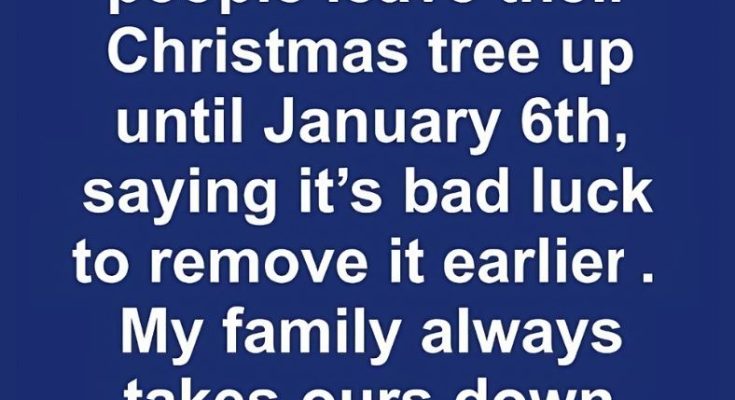For many, the festive season doesn’t end when the clock strikes midnight on December 25th. In fact, for some families, the Christmas spirit lingers until January 6th, a date rich in history, religion, and tradition. But why is this specific date so significant, and why do some people believe it’s bad luck to take down the Christmas tree earlier?
The Historical and Cultural Significance of January 6th

January 6th, widely celebrated as the Feast of the Epiphany, holds deep historical and cultural roots. This date marks the end of the Twelve Days of Christmas, a period starting on December 25th and culminating with the Epiphany. It commemorates the visit of the Three Wise Men, or Magi, to the baby Jesus. Their journey symbolizes the revelation of Christ to the Gentiles, making this day profoundly significant in Christian traditions.
In many cultures, the Epiphany is treated with as much reverence as Christmas itself. For instance, in Spain and Latin American countries, it’s known as “Three Kings’ Day” and is celebrated with parades, feasts, and gift exchanges. Leaving the Christmas tree up until this day honors the entirety of the Christmas season, embracing the full spectrum of its religious and cultural meaning.
The Role of Superstition: Why Taking the Tree Down Early Is “Bad Luck”
Ever heard of the superstition that removing Christmas decorations too early invites bad luck? This belief stems from the idea that the Twelve Days of Christmas are sacred. Interrupting this period by taking down the tree before January 6th could, according to folklore, disrupt the natural order of the season.
While not everyone takes this superstition to heart, it resonates with those who hold onto the spiritual and symbolic significance of the Christmas season. For these individuals, waiting until Epiphany to dismantle their tree is a way of respecting tradition and, perhaps, avoiding a streak of bad fortune.
How Christmas Tree Traditions Differ Around the World
Holiday customs are as diverse as the cultures that celebrate them. In the United States, it’s common for families to start packing away their Christmas decorations shortly after December 25th, with some even doing so before New Year’s Eve. Practical reasons, such as the hassle of maintaining a drying tree or preparing for the new year, often influence this decision.
However, in countries like Spain, Italy, and Greece—where Catholic and Orthodox Christian traditions are strong—trees and decorations typically stay up until January 6th or even later. These practices highlight the deep connection between religion and holiday customs, reflecting the varied ways in which the world celebrates Christmas.
Balancing Convenience and Tradition: Family Practices
Let’s face it—family traditions can vary wildly, even within the same neighborhood. Some families value practicality over tradition. They’ll take the tree down immediately after Christmas to avoid dealing with falling needles or the hassle of storing ornaments. Others prioritize the symbolic importance of the Epiphany and leave their tree up until January 6th.

The decision often boils down to what’s most meaningful for each household. For some, the act of keeping the tree up serves as a cherished nod to their faith or family heritage. For others, it’s simply about convenience and keeping life moving forward.
Religion’s Influence on Holiday Timelines
For many Christians, the liturgical calendar provides the rhythm for the holiday season. Christmas isn’t just a day—it’s a season that spans from December 25th to January 6th. The Epiphany is an integral part of this calendar, and keeping the tree up honors this timeline.
In Catholic and Orthodox traditions, Epiphany marks the final chapter of the Christmas story. By leaving the tree up until this date, families align their celebrations with the religious meaning of the season. For devout believers, this practice goes beyond tradition—it’s a way to deepen their connection to their faith.
The Emotional Comfort of Extending the Holidays

Let’s be real—taking down the Christmas tree can feel like the official end of the holiday magic. The festive lights, colorful ornaments, and twinkling decorations bring warmth and joy during the darkest days of winter. Why rush to let go of that?
For many, extending the holiday season until January 6th provides an emotional boost. It’s a way to hold onto the joy, togetherness, and magic of the season a little longer. This can be particularly comforting during the post-Christmas slump, when the excitement of the holidays begins to fade, and the reality of daily life looms.
Practical and Environmental Considerations
Of course, there are practical considerations too. For households with a real tree, leaving it up for an extended period can be tricky. A drying tree poses a fire hazard, and the hassle of cleaning up fallen needles isn’t exactly festive. On the other hand, artificial trees offer more flexibility, making it easier to keep them up until January 6th without any logistical issues.

Ultimately, it’s a balancing act. Some families weigh practicality against tradition and find their own sweet spot, whether that’s taking the tree down on December 26th or waiting until Epiphany.
Conclusion: Finding Your Own Balance Between Tradition and Modern Life
So, why do some people leave their Christmas tree up until January 6th? It’s a combination of religious tradition, cultural practices, personal beliefs, and, yes, even a touch of superstition. For some, it’s about honoring the full Twelve Days of Christmas and the significance of the Epiphany. For others, it’s about holding onto the holiday spirit just a little longer.
At the end of the day, the timing of taking down your Christmas tree is a personal decision. Whether you follow tradition, prioritize convenience, or just do what feels right for your family, the most important thing is to create a holiday experience that brings you joy and meaning. After all, isn’t that what the season is all about?



